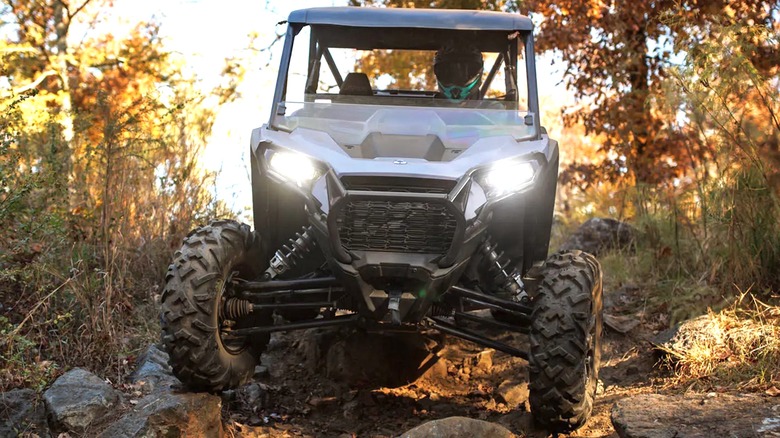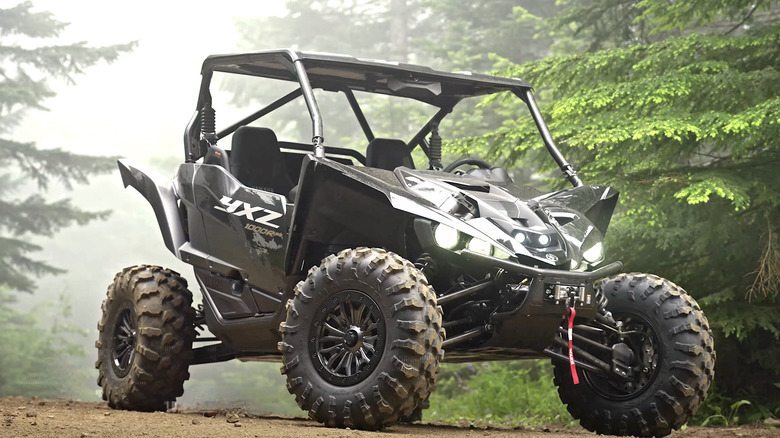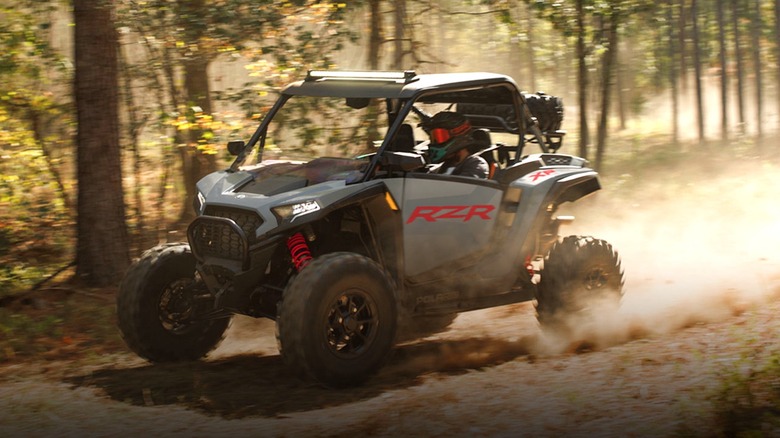Yamaha YXZ Vs. Polaris RZR: What's The Difference Between These Side-By-Sides?
There has, perhaps, never been a better time to be an outdoor enthusiast who enjoys hitting the trail in a four-wheeler, as there's no particular shortage of companies manufacturing such off-road-ready options these days. There are, of course, dozens of legit sport utility vehicles available from virtually every major automaker to choose from. But more and more, those who prefer to live life off the beaten path are turning to smaller side-by-side vehicles when setting out for a little off-roading adventure.
One could even make a case that there are too many side-by-sides for adventure seekers to choose from in the modern off-road market, with major players like Honda, Yamaha, Can-Am, Kawasaki, and Polaris all offering multiple makes and models of all-terrain vehicles. So plentiful are the options, it can be difficult to tell some of them apart — even if you've narrowed your selection of side-by-sides down to just two similar vehicles, such as the Yamaha YXZ and the Polaris RZR.
Of course, even side-by-sides cut from a similar cloth tend to be pretty different once you dig a little below the surface. Despite their class similarities and three-letter names, the Yamaha YXZ and Polaris RZR are very different off-roading beasts. Here's a breakdown of what sets these popular side-by-side all-terrain vehicles apart.
Breaking down the Yamaha YXZ
We'll start with the Yamaha YXZ, if only because the Japanese brand is, and likely always will be, one of the bigger names in the realm of off-road vehicles. The company has been manufacturing recreational off-road vehicles like side-by-sides since the early 2000s, and has grown its lineup to include three primary products, with trim levels putting the number of available models at more than a dozen. As it happens, the YXZ lineup accounts for just three of those trim levels, with the 1000R SS serving as the mid-range offering.
"Mid-range" is a relative term, of course, as the Yamaha side-by-side should provide any all-terrain rider with plenty of off-road kicks. The six-speed side-by-side comes fixed with Yamaha's all-new Auto Shift Technology, with the smooth shifting giving drivers one less thing to worry about when they're on the trail. The vehicle also boasts a punchy 998cc three-cylinder high-output engine that should enable you to tackle any trail ahead with ease, as should the vehicle's adjustable Fox shocks and its sizable ground clearance of 16.2 inches in the front and a full 17 inches at the rear.
As for the tires, the YXZ 1000R SS rides on knobby, 29-inch Maxxis Bighorn radials that should be as tough on the trail as they look. Unfortunately, the YXZ series is only available as a two-seater, so if you're looking to hit the trails with more than one passenger, this is not the model for you. Still, with a starting MSRP of $20,899 (plus $1,225 destination fee), it's more affordable than many other side-by-sides, including the SlashGear-approved Can-Am Maverick R.
What the Polaris RZR has to offer
Compared to the pricey Can-Am Maverick, both the Yamaha YXZ and Polaris RZR look like steals. With a price tag starting at $19,999 (plus $1,195 destination), the latter is more affordable than its Yamaha counterpart. While Yamaha is generally regarded among the best of the major motorcycle manufacturers, Polaris is better known for manufacturing specialty vehicles like golf carts and snowmobiles, as well as the fun and stylish Slingshot R trike.
Surprisingly, the company didn't release its first legit side-by-side all-terrain vehicle until 2007. If you're familiar with Polaris' side-by-side history, you'll know that vehicle arrived with the RZR nameplate, which has remained in the company's lineup ever since. The RZR has evolved considerably since its '07 debut, and the 2025 model has plenty to offer off-road enthusiasts, including a powerful ProStar 1000 Gen 2 Engine capable of cranking out 114 horsepower. The vehicle also comes stock with 29-inch trail-ready tires and Walker Evans Racing Needle Shocks, which, when combined with a 90-inch wheelbase, should keep you on the trail and right-side up for the duration of your ride.
Unlike the Yamaha, the Polaris RZR is available in a four-seat model, though the extra length and seats push the starting price up to $22,999 (plus $1,295 destination). Despite the additional cost, it's safe to say that the extra money is worth it if you're regularly going to have extra passengers. And did we mention that the RZR also boasts a full skid plate to protect its underbelly on the trail? It does. And the Yamaha side-by-side cannot make that claim.


